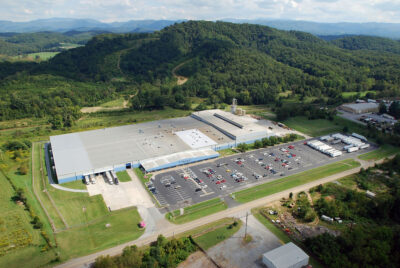Copeland Furniture, based in Bradford, VT, manufactures contemporary, solid hardwood furniture for the bedrooms, dining rooms and home offices. Copeland purchases about 1 million board feet annually of Walnut, Cherry and Northern Red Oak (4/4, 5/4, 6/4, and 8/4, No. 1 Common).
Tim Copeland and his crew have been handcrafting high-quality, elegant, solid hardwood furniture since the 1970s. “We set out in the early 1970s to make wood products from natural hardwoods,” Tim Copeland, the CEO of Copeland Furniture, said. “Initially, we made cider presses for home and small-scale orchard use. From there our designs evolved into the butcher-block kitchen furniture and Adirondack-style porch furniture, items that were functional and affordable for baby-boomers as they furnished their first homes.”
He continued, “During our many periods of growth, we have changed from a one-man operation in an old garage in East Corinth, VT, to a state-of-the-art manufacturing facility located on the banks of the Connecticut River in Bradford, VT. Using a combination of leading-edge computer technology and traditional craftsman technique, we have created an enterprise that is embedded in our local community, a place that provides a fulfilling work environment for the men and women who come to work here every day.”
Since the beginning, Copeland Furniture has sought to stay loyal to its mission to produce furniture for discerning consumers who have an appreciation for good design, quality and value. “We have also worked hard to stay loyal to the New England tradition of quality craftsmanship,” said Tim. “Our work ethic embraces the belief that continuous improvement is ultimately what best serves the customer. We strive to meet expectations and make the best furniture we possibly can,” he added.
Copeland Furniture’s natural hardwood furniture is made at their factory in Bradford. “We create original furniture designs inspired by our New England surroundings and key historic furniture design movements of the past, particularly Shaker, Mission and the Arts & Crafts styles,” he said.
“We use traditional cabinet making techniques in our factory where Maple, Cherry and Walnut lumber is cut, sanded and hand selected as part of the process to build our furniture. Our assembly team devotes special care and attention to ensure that all the joinery is clean, flush and smooth to the touch,” Tim explained.
Copeland uses special construction techniques to compensate for the changes in moisture content that occur in solid hardwood furniture; wood can expand or contract based on air humidity levels. Tim explained, “This is very important in drawer construction for example. We use adjustable wooden glides so that the drawers will open and close smoothly throughout the life of the furniture piece.”
At Copeland Furniture sustainability goes beyond the correct use of hardwoods. “We want to use all of our resources responsibly,” Tim said. “We use sustainably harvested hardwoods from the American Northern Forest, much of it within 500 miles of our factory, consuming less energy in transporting raw material to the factory,” he added.
Conscious about not only the resource of the product but the energy consumed in the process, Copeland has invested over two million in solar arrays that produce about 95 percent of the operation’s electricity. “Our factory uses about 1.2-million-kilowatt energy per year. Producing that much energy with fossil fuel would require more than 600 tons of coal or 80,000 gallons of oil. Our timber comes from well-managed wood lots where hardwoods are naturally regenerating at a pace that exceeds the rate of harvest. This rate of use is sustainable for generations to come. We collect the sawdust and shavings to feed our biomass boilers. This has reduced our reliance on heating oil by 95 percent. We’re amazed at how much we can do with just sawdust and shavings. We use finger-joint equipment to create furniture specifically designed to be made entirely of what used to be used as boiler fuel. We give away the small pieces that are left, that are too small to use in furniture. We give those pieces to the community to use as firewood. We use Greenguard-certified finishes that are ultra-low on emissions ensuring our product is safe. People ask me why sustainability is important to us. In a very real sense, the land sustains us and we have a historic interest in conservation and stewardship of the land because it was simply taught to us as a core value. We apply that same concept of stewardship and conservation in building and designing our furniture. Build it right, build it once and eliminate the need for replacement,” explained Tim.
Dedication to quality and craftsmanship at Copeland doesn’t stop with ownership, long-time assembly department employee, Charles Morse II said, “I’ve been a carpenter my entire life. When I look at wood I don’t see ‘just a piece of wood.’ I see a project. Quality is everything. The quality of the product is determined by the amount of pride that is taken in the work. That’s our goal at Copeland. I’m proud that our products are American-made and I feel like Mr. Copeland himself is American-made. When people buy from Copeland they’re investing in their dreams.”
Copeland Furniture is a member of the American Home Furnishings Alliance and the Sustainable Furnishings Council.
For more information email tim@copelandfurniture.com, call 802-222-9282, or visit www.copelandfurniture.com.






